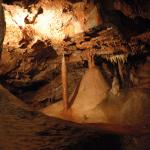Kents Cavern, Torquay, Devon
Kents Cavern is an important prehistoric cave system, notable for both its archaeologyThe study of the things humans have left behind. See 'Some Notes of Archaeology'. and its geologyThe science of studying the Earth and its past.. The cave system was formed by water in the early PleistoceneA geological epoch with many ice ages and interglacials. It ran from 2.58 million years ago until 11,700 years ago. See 'A Brief History of Climate Change'., and shows many of the usual geological features of a calcium-rich area (such as stalactites and stalagmites). The oldest bones found within the caves, belonging to a cave bear, are around 500,000 years old. Other species of animal found within the caves include hyenas, mammoths, sabre-toothed cats and cave lions. However, it wasn't just animals that used the cave system: evidence of use by humans, in the form of worked flints, suggests they too were using the caves from about half a million years ago. Kents Cavern can also boast NeanderthalAn extinct species (or subspecies) of human who lived in Eurasia between up to 600,000 years ago (the first 'true' Neanderthals being from around 250,000 years ago) and about 40,000 years ago. They lived alongside modern humans and interbred with them. artefactsObjects made by humans that are of historical interest. and the oldest modern human bone fragment found in Britain.
Access to the caves is through guided tour, about an hour in length, which shows visitors many notable cave features, including the dragon and cave face, as well as where items of historical interest were found, such as fragments of jaw bones, hominin and cave bear skulls, seashells used as candle holders and Roman offerings. There is a story behind each one, which the guide told in an interesting and informative way. For someone with an interest in both history and geology, some of the information seemed a little out of date, or one-sided, but it was a good attempt to get the main points across in so little time. As parents of young children, we were worried that a guided tour, particularly in a potentially claustrophobic environment, would be too much for them. However, the tour guide was so engaging, and there was so much to see, that this was not an issue. The caves on the tour, as well as the paths between them, have been concreted, which does take away from some of the atmosphere and accuracy, but does make the caves infinitely more accessible (although some of the paths are quite steep, so it might still be difficult for wheeled mobility aids or pushchairs).
The main focus of the site is, of course, the guided tour. However, there are a number of other activities which can be done either onsite or using it as a base. Onsite, there are children’s activities, including rock painting, digging for gems and a number of trails (there is a small prize on completion). For those more active, there is also a trail around the headland, which is just under three miles long and, due to its nature, is estimated to take around 2 hours to complete. This trail takes the walker past various rock formations, thus broadening the geological learning available. There is therefore something for everyone, and a full afternoon is needed to complete all that is on offer. There is also a well-stocked shop (although I would have liked to have seen more books on prehistoryThe time in the past that happened before history began to be recorded. and geology there) and a café so that a visit could be extended to last at least four hours. As such, the family ticket price of £31.50 is reasonable value for money.
As somewhere that is so historically important, this attraction is a must visit for anyone with a love of prehistory, and even those who have a passing interest will find it interesting. For me, it was the highlight of my weekend.
To find out more about Kents Cavern, click here.
- Log in to post comments







